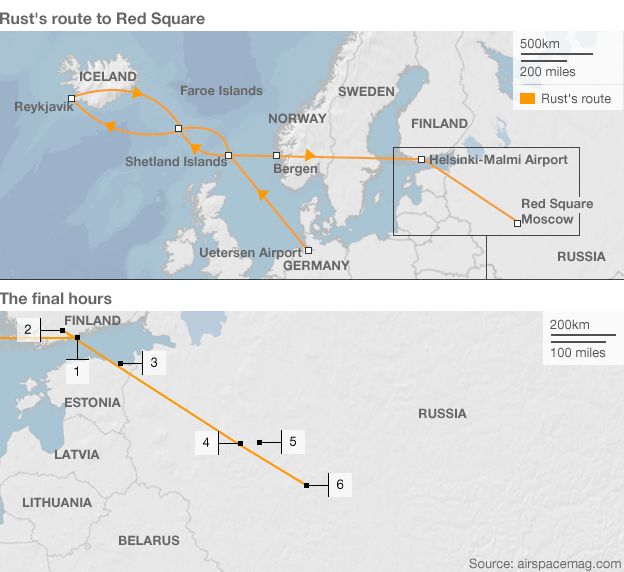| The Cessna airplane Rust flew right into the Red Square |
 |
| Mathias Rust - "Of course I was afraid to lose my life." |
During Rust's actual flight he first stopped in the Shetland Islands in the UK, and then the Faroe Islands. He spent one night in each. Next came the Reykjavik, then Bergen in Norway before he arrived on May 25th in the Helsinki, the capital of Finland. He spent several days there trying to decide if he really had the courage to go through with his plan. The USSR had the largest air defence system in the world at the time. Less than five years earlier, the Korean Air Flight 858 had been shot down after straying into Soviet airspace, causing the death of all 269 passengers on board. On the morning of May 28th, he told the air traffic control in Helsinki he would be heading to Stockholm. Back in Helsinki, the air control operators began to worry. Rust was heading in the wrong direction and then vanished from their radar screens before they could contact. An enormous manhunt was launched by the Finnish coastguard and when a patch of oil was spotted on the sea surface, divers were brought in to search for a wreck. At the same time as this manhunt, Rust was sitting safely, for now, in his cockpit as his plane crossed into Soviet airspace.
The Soviet radars saw his presence within an hour and a combination of unbelievable luck and human error had led to Rust's plane being mistaken for a friendly aircraft. Rust's goal was to land right in the middle of the Red Square but this was proving to be very difficult to achieve since there were a ton of people walking through the center of it. Instead, Ruscontinuallyly flew only 30 feet above the Red Square as the citizens watched in awe as the plane flew above. Finally Rust spotted a bridge next to St Basil's Cathedral and decided to instead touch down there. Later, when he was questioned by the Russian police, he learned that the bridge was usually spanned by thick cables, by chance, they had been removed from the bridge that very morning for maintenance, allowing him to land. He told the police that questioned him that he was "on a peace mission from Germany", the Soviet police force then shook his hand assuming that he was from East Germany, not the West. Rust ended up being sentenced to 4 years in a labour camp and as a result, the minister of defence had been forced to retire, and the head of the air defence services had been sacked. Over the next few months, more than 150 people lost their jobs.
To my dad and many others at the time, this began to really show how the Soviet Union was beginning to lose power and could no longer really be considered the massive superpower that it was in the decades before. 2 years later, the Berlin Wall came down and the Cold War came to an end.
Here is a video of his landing: (35 seconds)
Source: http://www.bbc.com/news/magazine-20609795

This is a crazy story! There were many instances of people fighting this oppressive regime. Samizdat was the underground publishing of literature banned by the state. Samizdat means "self-published", as opposed to gosizdat's meaning of "state-published". A related term is tamizdat, "published over there", which was material smuggled into the USSR, such as records of prohibited music, including rock compositions. So, as you can see, the USSR faced resistance from both within and outside its boundaries, despite oppressing those who were caught.
ReplyDeletehttp://www.bbc.com/culture/story/20170724-the-writers-who-defied-soviet-censors
Wow what an interesting post! Great job! Apparently, today, Mathias Rust who is now 44 feels that the mission was irresponsible and he wouldn't do it again. After his mission, he was seen as a hero, however his reputation collapsed once he decided to stab a nurse in training who apparently did not receive his affection.
ReplyDeletehttps://www.theguardian.com/world/2012/may/14/german-red-square-cold-war
Woah Belen, this is really cool! It's pretty awesome that your father was so close to the front lines of the Cold War. I was reading a little about Mathias Rust, and it turns out that Mathias's actions had a larger impact than most people realize. Because of Rust's flight, Gorbachev was able to release several hard-liners who were opposing his reforms. He was able to do so because of the failure of the military to handle Rust's incursion into Soviet airspace. Some of the officers that he purged were Defense Minister Sokolov and Alexander Koldunov, two Stalin-era officials who were against Gorbachev's reforms. All of the releases were done peacefully, however, unlike the Stalinist purges of the decades past. This was largely due to Rust's flight. It's interesting to see how a lucky teenager was able to influence the Cold War to such an extent.
ReplyDeletehttp://www.bbc.com/future/story/20170526-the-audacious-pilot-who-landed-in-red-square
Belen, this is a very interesting post. Learning about the amazing story of Rust was extremely thought provoking, and having your dad be so close to this event is very cool. I think that the release of Mathias Rust was very interesting as well. In 1988, after Reagan and Gorbachev signed massive nuclear-weapon reductions, the Soviets released Rust as a sort of gesture of goodwill. This shows that the lessening of tensions between the Soviets and the West had profound effects. Allowing the release of such a controversial figure showed a real progress between the two countries during this time, and also showed that the Soviets were committed to finding peace.
ReplyDeletehttps://www.airspacemag.com/history-of-flight/the-notorious-flight-of-mathias-rust-7101888/?all